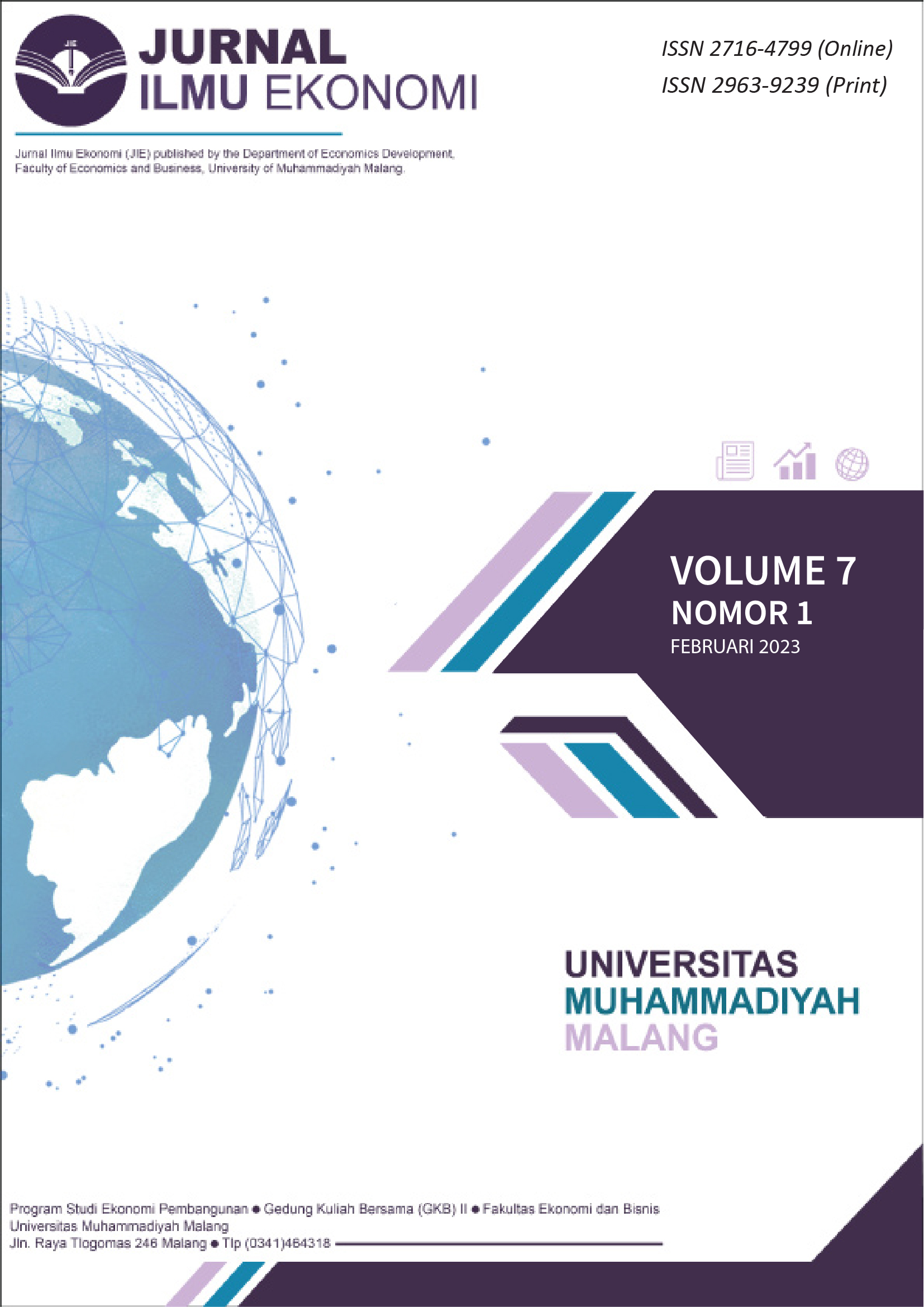Hubungan Antara Tingkat Konsumsi Energi Listrik dengan Pertumbuhan Ekonomi di Indonesia
DOI:
https://doi.org/10.22219/jie.v7i01.25042Keywords:
economic growth, electricity consumption, investment, regional spending, regression analysisAbstract
This study aims to determine the relationship between electricity consumption and economic growth in 34 provinces of Indonesia. The method used is multiple regression. From the data processing, it is obtained that all independent variables simultaneously have a significant effect on the dependent variable. Partially the variables of Electrical Energy Consumption, Total Investment, and Regional Expenditures have a significant effect. In contrast, the variable Population has no significant effect on the variable Economic Growth in 34 provinces of Indonesia. It can be concluded that there is a relationship between electricity consumption and economic growth in 34 provinces of Indonesia.
Penelitian ini bertujuan untuk mengetahui hubungan antara tingkat konsumsi energi listrik terhadap pertumbuhan ekonomi di 34 provinsi Indonesia. Metode yang digunakan adalah Analisis regresi berganda. Dari olah data yang dilakukan diperoleh hasil bahwa seluruh variabel bebas secara simultan berpengaruh signifikan terhadap variabel terikat, sedangkan secara parsial variabel Konsumsi Energi Listrik, Total Investasi, dan Belanja Daerah berpengaruhi signifikan, sedangkan variabel Jumlah Penduduk berpengaruh tidak signifikan terhadap variabel Pertumbuhan Ekonomi di 34 provinsi Indonesia. Dapat disimpulkan bahwa terdapat hubungan antara konsumsi energi listrik dengan pertumbuhan ekonomi di 34 provinsi Indonesia.
Downloads
References
Arianto, C. E., Adenan, M., & Dwipayana, I. (2015). Pengaruh Jumlah Penduduk dan Angka Pengangguran Terhadap Pertumbuhan Ekonomi Kabupaten Jember. Jurnal ISEI (Ikatan Sarjana Ekonomi Indonesia), 5(1), 151–160. http://repository.unej.ac.id/handle/123456789/62936
Badan Pusat Statistik Indonesia. (n.d.). Jumlah Penduduk. https://www.bps.go.id/
Costantini, V., & Martini, C. (2010). The causality between energy consumption and economic growth: A multi-sectoral analysis using non-stationary cointegrated panel data. Energy Economics, 32(3), 591–603. https://doi.org/10.1016/j.eneco.2009.09.013
Kasperowicz, R. (2014). Electricity consumption and economic growth: Evidence from Poland. Journal of International Studies, 7(1), 46–57. https://doi.org/10.14254/2071-8330.2014/7-1/4
Kocaaslan, O. K. (2013). The causal link between energy and output growth: Evidence from Markov switching Granger causality. Energy Policy, 63, 1196–1206. https://doi.org/10.1016/j.enpol.2013.08.086
Kraft, J., & Kraft, A. (1978). On the Relationship Between Energy and GNP. The Journal of Energy and Development, 3(2), 401–403. http://www.jstor.org/stable/24806805
Mahriza, T., & Amar B, S. (2019). Pengaruh Investasi Dalam Negeri, Investasi Asing, Tenaga Kerja Dan Infrastruktur Terhadap Perekonomian Di Provinsi Sumatera Barat. Jurnal Kajian Ekonomi Dan Pembangunan, 1(3), 691. https://doi.org/10.24036/jkep.v1i3.7697
Marwa, T., Bashir, A., Atiyatna, D. P., Hamidi, I., Mukhlis, M., & Sukanto, S. (2022). The Link between Economic Growth, Electricity Consumption, and CO2 Emissions: Evidence from Indonesia. Signifikan: Jurnal Ilmu Ekonomi, 11(2), 253–272. https://doi.org/10.15408/sjie.v11i2.26286
Noor, S., & Siddiqi, M. W. (2010). Energy consumption and economic growth in south asian countries: A co-integrated panel analysis. World Academy of Science, Engineering and Technology, 67(7), 251–256.
Oh, W., & Lee, K. (2004). Causal relationship between energy consumption and GDP revisited: The case of Korea 1970-1999. Energy Economics, 26(1), 51–59. https://doi.org/10.1016/S0140-9883(03)00030-6
Putri, S. A., & Cahyono, H. (2016). Pengaruh Belanja Daerah Dan Pmdn Terhadap Pertumbuhan Ekonomi Di Jawa Timur. Jurnal Pendidikan Ekonomi (JUPE), 4(3), 1–7.
Stern, D. I. (1997). Limits to substitution and irreversibility in production and consumption: A neoclassical interpretation of ecological economics. Ecological Economics, 21(3), 197–215. https://doi.org/10.1016/S0921-8009(96)00103-6
Tertzakian, P., & Hollihan, K. (2009). The End of Energy Obesity: Breaking Today’s Energy Addiction for a Prosperous and Secure Tomorrow. John Wiley & Sons.
Toman, M. A., & Jemelkova, B. (2003). Energy and Economic Development: An Assessment of the State of Knowledge. Energy Journal, 24(4), 93–112. https://doi.org/10.5547/ISSN0195-6574-EJ-Vol24-No4-5
Trisnu, C. I. S. R., & Purbadharmaja, I. B. P. (2011). Pengaruh PMDN dan PMA Terhadap PDRB di Provinsi Bali. Time, 2(December 2010), 1–192.
Wang, C., Wang, A., & Wang, C. (2011). Analyze the relationship between energy consumption and economic growth in China. Energy Procedia, 5(2), 974–979. https://doi.org/10.1016/j.egypro.2011.03.172
Zhang, Z., & Ren, X. (2011). Causal relationships between energy consumption and economic growth. Energy Procedia, 5, 2065–2071. https://doi.org/10.1016/j.egypro.2011.03.356
Downloads
Published
How to Cite
Issue
Section
License
Copyright (c) 2023 Prastika, A.

This work is licensed under a Creative Commons Attribution-NonCommercial-ShareAlike 4.0 International License.
Authors who publish with this journal agree to the following terms:
- For all articles published in the JIE (Jurnal Ilmu Ekonomi), copyright is retained by the authors. Authors give permission to the publisher to announce the work with conditions. When the manuscript is accepted for publication, the authors agree to the automatic transfer of non-exclusive publishing rights to the publisher.
- Authors retain copyright and grant the journal right of first publication with the work simultaneously licensed under a Creative Commons Attribution-NonCommercial-ShareAlike 4.0 International License that allows others to share the work with an acknowledgement of the work's authorship and initial publication in this journal.
- Authors are able to enter into separate, additional contractual arrangements for the non-exclusive distribution of the journal's published version of the work (e.g., post it to an institutional repository or publish it in a book), with an acknowledgement of its initial publication in this journal.
- Authors are permitted and encouraged to post their work online (e.g., in institutional repositories or on their website) prior to and during the submission process, as it can lead to productive exchanges, as well as earlier and greater citation of published work (See The Effect of Open Access).
This is an open access article and licensed under a Creative Commons Attribution-NonCommercial-ShareAlike 4.0 International License








